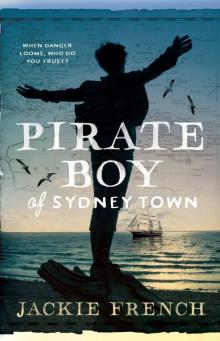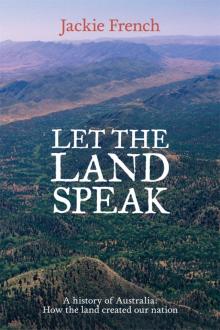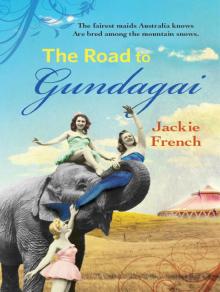- Home
- Jackie French
Let the Land Speak
Let the Land Speak Read online
Dedication
To the past, present and future generations,
with gratitude, love and hope.
And to this valley,
which has given me the heart of my life and work.
Contents
Cover
Title Page
Dedication
Introduction: the goat droppings that changed history
1. The real First Fleet
2. The Ice Age that made three hundred nations
3. Cooperate or die
4. The women who made the land
5. Terra incognita: Dreams of gold, and a land without grass
6. The goat, the grocer’s assistant and the mistake that led to a nation
7. The colony that didn’t starve
8. The second, third and fourth Australians
9. The lost tigers and the sheep that ate Australia
10. How we almost won Eureka
11. The history of our nation in a pumpkin scone
12. How a drought made us one nation
13. Truth or propaganda? The bronzed Anzacs of Gallipoli and Kokoda
14. A land of flooding rain
15. A short history of great big farming misunderstandings
16. This generous land: Terrapaths, moral omnivores and how to survive the next millennia
17. The next hundred years: Twenty-four predictions
Picture Section
Notes
Bibliography
Acknowledgements
Searchable Terms
About the Author
Copyright
INTRODUCTION
The goat droppings that changed history
It began with a goat.
When James Cook and HM Bark Endeavour sailed from Plymouth in 1768 on the voyage that would first map eastern Australia (and led to the British settling a colony there twenty years later), the tiny ship, about twice the size of a suburban house, carried seventy-one crew, twelve marines, and eleven scientists and their servants. It also held seventeen sheep, a small mob of cattle for meat, four ducks, four or five dozen hens (which lived in the ship’s boats) for eggs – no roosters, as hens can’t hatch chicks in a ship’s boat in wild seas – a boar to mate with a sow, her piglets, two greyhounds, and three cats to catch the rats that swarmed on every ship.1
It carried a goat, too.
The goat and sheep would help save the Endeavour when she was wrecked on the Great Barrier Reef, their dry dung spread on the inside of an old sail that was wrapped around the shattered hull. As the dung drew up water the sail clung to the ship, making an almost watertight seal. If it hadn’t been for those goat and sheep droppings, no British colony would have been sent to New South Wales in 1788, or possibly ever, as that colony was sent only because of the enthusiastic but wildly inaccurate reports of one of the passengers on the Endeavour, wealthy amateur botanist Joseph Banks, who had provided most of the funds for the voyage.
I discovered the goat accidentally, hunting up English newspaper reports of the Endeavour’s return, and there she was, getting almost as much press as publicity-hungry Banks. But once I knew about the goat, and all the other animals crammed onto that small ship, I looked at the Endeavour letters and diaries – and a large chunk of Australia’s history – in a new light.
The Endeavour, like other ships of its time, was a floating ark, with its cattle and breeding pigs, and hens that needed to be removed from the ship’s boats before any expedition to explore the shore. In the days before refrigeration, ships had to carry live animals to feed the crew on their long journeys.
Even more importantly for Australian history, those small ships couldn’t carry enough fodder to feed the animals. If you carried animals, you needed to go ashore to cut grass to feed them. Often. You needed fresh water, too, which can be difficult to find in unmapped territory, and especially hard in Australia, unless you know the land well. When you read the ship’s log and diaries kept on the Endeavour during her visits to places like New Zealand or even bitterly cold Tierra del Fuego, a couple of phrases reappear over and over: ‘cut grass’ and ‘filled water barrels’.
The goat, and her grass, made me realise that, like many other historians, I had misunderstood why Australia had been ignored by most of the world for so long. At school we were taught that it was because our land was dry, barren and useless; and because Australia had no gold or spices. The conventional story is that this continent was too far away to be of interest, an unknown land of unknown people, until James Cook surveyed the east coast. Australia has been portrayed as a Sleeping Beauty, waiting for the English hero to arrive and wake her up.
None of this is accurate. The land we now call Australia and its inhabitants had been known to the outside world for thousands of years. From at least two thousand years ago, and possibly even earlier, the continent and its many Indigenous cultures were only a couple of days’ sailing south of the trade routes to the Spice Islands (Ambon and the Maluku islands of present-day Indonesia), the source of vast wealth for many trading, and later colonising, nations. Australia had and has native spices too, including some very similar to the ones being traded, like native pepper and native ginger. (They remain relatively unknown because the ‘traditional’ European species are now cheap and readily available.) Australian spices and valuable cedar trees were noted by the Dutch long before the Endeavour sailed up the east coast. Australia’s northern soil and climate were also suitable for plantations of cinnamon, allspice, vanilla, pepper, sugarcane and coffee, the crops on which fortunes had been made for at least four thousand years. But both the existing spices and the potential crops remained unexploited by outsiders.
Why? Most of the north and west of the mainland and part of Tasmania had even been mapped long before James Cook and his crew reached our shores in 1770. Parts of the north were reasonably similar to nearby areas that had been colonised. Much of the west looked barren, but strategically useful places that were just as barren had been settled before, and the area around the Swan River in the west and most of Tasmania appeared green and fertile. A port on the southwest coast would have been a useful supply depot on the route to the major trading settlement of Batavia (now Jakarta).
However, Australia lacked grass: that lush, sweet grass that can be cut and dried to take on board and feed essential animals like Cook’s goat. Australia’s native ‘grasslands’ are made up of hundreds of ground covers, but many of them are toxic to sheep, goats and cattle2. In years to come the first European colony in Western Australia would struggle until the poisonous ones were identified, and their animals stopped dying. Most native Australian grasses grow in tufts, and nowhere near as lush as European grasses, or African ones like kikuyu. Without grass, Australia was relatively useless as a supply port.
But most of all, sailing ships need safe harbour from winds and storms. Australia has few great rivers like those of Europe and the Americas, that carved out harbours where they reached the sea and gave rich flood plains of grass to scythe and take on board. Even skilled navigators like James Cook either missed or was unable to enter the superb harbours that we do have, like Sydney Harbour and Moreton Bay.
And the Australian coast does have extreme winds: the ‘roaring forties’ that pummel Western Australia, the bitter southern ocean gales that Tasman warned other sailors to be wary of, the southerlies of the east coast that can be deadly even for today’s well-engineered yachts in the Sydney to Hobart race.
Australia wasn’t sitting at the end of the world, waiting for a hero like Cook to find her. The land itself, our geography, prevented earlier colonial expansion because these basic necessities – grass and safe harbour – could not be found. The goat, and all her implications, made me reassess other crucial area
s of Australia’s past, looking at the role the land itself has played in determining our history, and how that role has been underestimated. Once I began to look, there was a lot to find.
Australia’s geographic position in large part determined who came here, from the founders of perhaps 60,000 years ago, to the desperate and the dreamers of the past two hundred years, and the boats that still arrive today. Indigenous cultures were shaped by the different areas they inhabited, but they would also change the land. ‘Firestick farming’ is a relatively well known concept now, even if its application is often misunderstood, but the even more profound reshaping of the landscape by Indigenous women is still vastly underestimated.
Australia’s erratic weather patterns determined our first gold rushes.3 Gold had been discovered many times before the ‘rushes’ of the late 1840s and 1850s, but gold panning needs water, and gold miners need food, and until the breaking of the 1840s drought there wasn’t enough of either.
Australia would become one nation because of another series of droughts so severe that they revolutionised our politics, social life and economy. The men who fought at Gallipoli would be shaped by the land, as were the ‘koala soldiers’, the militia boys of World War 2 who helped slow down the seemingly unstoppable advance of the Japanese army heading this way for the Australian resources they desperately needed.
Five hundred years of misunderstandings
Australia’s climate, soils, and varied ecologies have also been profoundly misunderstood, with disastrous consequences. Our first English colony at Sydney Cove was founded only because Joseph Banks misconstrued almost everything he saw at Botany Bay, from the rare green grass and fresh water of an unusually wet year to a ‘safe harbour’ that almost wrecked the First Fleet. Governor Hotham’s misunderstanding of the vast spread of deep mine workings at Ballarat made him see wealth, instead of desperation, prompting him to impose a mining tax too high for miners to afford, which lead to the iconic struggle at Eureka.4 Hotham’s strategic military experience would also enable him to use the darkness of the diggings as a weapon, so that his troops could win against a far larger force. Underestimating that power of darkness, especially in terrain with deep unfenced pits, led to the often repeated myth that the Eureka stockade could never have triumphed.5
Our past misunderstandings of the land continue to shape the decisions we make today. This is a generous land, but the myth of a barren continent allows us to perpetuate the ideology that the bush must be transformed to have value: logged, turned into plantations, the rivers dammed, or the land carved into fenced paddocks and irrigated to be productive. The myth of ‘endless land’ and a narrow Eurocentric vision of what ‘proper farms’ were like would turn millions of hectares almost into desert.
Humans get attached to myths. Once we see the world – or history – in a certain way, it’s difficult to budge the illusions. Hundreds of years ago European nations sent ships into the Pacific to find the land of gold they believed must be there, even though there was no evidence to support such a belief. As I write this, our government’s economic policy is being shaped by a similar myth, which vastly overestimates the importance of mining to our economy. At the same time the development of those mining resources is still hampered by the lack of political insight to create the harbour, road and other infrastructure that our industries need.
The oversimplification that the whole of Australia was shaped by Indigenous ‘firestick farming’ has led to disastrous bushfire strategies. Our planners also fail to remember or understand our history of floods, storm surges and drought, and this failure means that flood, storm surges and sea-level rises, all easily predicted, will continue to cause tragedy, year after year. It is air-conditioned, centrally heated policy, far removed from the physical and social circumstances they write about. It is easy to forget or underestimate flood, fire and drought unless you have lived through their desperation.
From terra incognita to Eureka, Federation and the decisions governments must make today, the land’s influence is often ignored or misunderstood. To understand the present, you need to understand the past. And to fully understand Australia’s history, you need to look not just at how the land has shaped our past but how it will continue to shape our future.
This book is the story of the land’s influence on iconic Australian events. It is as much memoir as history. It is difficult to realise the significance of ‘cut grass’ and ‘found water’ unless grass and water have been essentials in your life.
I grew up on the edge of suburban Brisbane, but our backs were always against the bush. The men of our street played cricket and fought bushfires together, and searched for and rescued a kidnapped child, a way of life that had served them well when they fought on faraway battlefields. My father-in-law fought at Gallipoli; my father’s friends died at Kokoda. (My father’s appendix burst during embarkation. He probably survived because of it. He felt the guilt all his life.) Those cricket matches and bushfires and weekends shooting pigs or rabbits were their training ground. To understand the battles, you need to understand the men who fought them. To understand those men, you need to know the land and how they lived with it. Perhaps to truly understand colonial and pre-colonial life, you need to have experienced life as they knew it.
In my twenties and early thirties I lived in a bush shed, with lamplight or darkness, much as women have lived here for tens of thousands of years. I still live in the same shed at the end of the Majors Creek gorge in the Araluen Valley in the Southern Tablelands of New South Wales, but the shed is now a house, and we have light when we want it, which is not as often as those who have never learned to love darkness, the thousand shades of dawn and twilight, or the purple shadows from the moon. It is a valley where the mullock heaps from the gold dreams of the 1850s have been turned into peach orchards, where the steepness and inaccessibility of the gorge country has created almost a world beyond time, so the quolls and rock wallabies and forests of neverbreak trees still survive.
For years I grew most of our food and other necessities, or gathered or hunted it in the bush around my house. It was a life without modern conveniences: learning to light a fire without matches; cooking on a fire; cutting stringybark to roof a lean-to; cutting tracks with brush hook and mattock; building a house from local stone; watching the honey drip from fresh honeycomb as my grandmother taught me; and knowing that if I miscalculated and served too many of the potatoes from the sacks in the shed, we’d have no potatoes to plant in spring. I still walk my land each morning, watching and noting its changes and seasons. I still grow and gather, although now from fulfilment, not poverty. At various times and places since I was sixteen years old, both white and Indigenous women have passed on traditions rarely glimpsed by male anthropologists, and possibly not fully understood unless you too live a life in which you need to use the lore passed on to you. Somewhere in the past few decades I realised I could predict what the next season would bring – for this valley, at least – with more accuracy than the weather bureau.
Much of my professional life has been spent studying the patterns of the land to create theories of pest and weed management, and tracing new paths through old documents to create patterns from the past that would eventually become historical fiction and non-fiction. Writing those books, and making a living from doing so, has allowed me the privilege of following historical obsessions, ferreting out source material or hiring others to do so, seeking firsthand accounts of the past and then turning them into stories.
The whispers from the land
History is stories. Some of them – not necessarily the most accurate or unbiased – get written down.
This is also a book of stories. My family were and are storytellers, with a passion for putting the tales passed on over generations into historical context, like my grandmother’s tales of how desperation in the 1890s drought led to the atrocities of child labour that gave the women of the temperance and suffrage movements their passion to campaign for reform and Federation.
This book comes from six decades of listening to stories, and four decades of watching the land. The land is one of the great players of our past, and is still here to be studied, and its lessons applied to our history.
As I sit by the creek I can trace the clematis ‘road’, planted perhaps tens of thousands of years ago by Indigenous women to guide the girls to the stringybark harvest. As each vine dies, seedlings grow to take its place. Further up the ridges my husband and I traced the kilometres of water race dug and built by Chinese gold miners in the 1850s and 1860s, then used by their descendants to bring water to grow vegetables. The white irises just beyond our lower boundary are the only sign left of the Poverty Gully ‘susso camp’ of the 1930s, where hundreds camped in shanties made of corrugated iron and flattened kerosene tins. The grove of damson plums, each lichened trunk wider than I am, was the first of the orchards in this valley. Each piece of knowledge changes and deepens the understanding of the past.
When you know one area well you realise that there is no such thing as ‘the bush’. Australia was once more than three hundred Indigenous nations6, and this land is still far too ecologically diverse for any ‘one size fits all’ planning policy. Modern science’s ability to understand the land and its history is giving us new insights or reinforcing old ones, but despite disasters and the even wilder swings of climate predicted, these voices of understanding become fewer as year after year research funding is slashed.
The past matters. The patterns of the past help predict when the gang-gangs will fly down from the mountains, when the boulders will crash down the gorge in the next flood, or when the wombats will scream in their mating chases. They also help predict stockmarket falls and political battles. These patterns are the foundation for the predictions in the final chapter. The boats will keep coming, as they have come for 60,000 years. So will drought, flood, fire, storm surge and covetous eyes on our resources.
To understand our history, you need to understand the land. Individuals, cultures, persistent ideologies (substantiated or not) and the innate nature of humanity are major forces too. But the land itself is underestimated.

 Christmas Lilies
Christmas Lilies The Lily in the Snow
The Lily in the Snow The Schoolmaster's Daughter
The Schoolmaster's Daughter Christmas in Paris
Christmas in Paris Lilies, Lies and Love
Lilies, Lies and Love The Last Dingo Summer
The Last Dingo Summer Legends of the Lost Lilies
Legends of the Lost Lilies Just a Girl
Just a Girl Pirate Boy of Sydney Town
Pirate Boy of Sydney Town Night Ride into Danger
Night Ride into Danger The Secret of the Youngest Rebel
The Secret of the Youngest Rebel My Name is Not Peaseblossom
My Name is Not Peaseblossom Goodbye, Mr Hitler
Goodbye, Mr Hitler Somewhere around the Corner
Somewhere around the Corner Dingo: The Dog Who Conquered a Continent
Dingo: The Dog Who Conquered a Continent Facing the Flame
Facing the Flame Dark Wind Blowing
Dark Wind Blowing Pennies For Hitler
Pennies For Hitler They Came On Viking Ships
They Came On Viking Ships To Love a Sunburnt Country
To Love a Sunburnt Country The Ghost of Howlers Beach
The Ghost of Howlers Beach The Girl from Snowy River
The Girl from Snowy River Phredde and the Purple Pyramid
Phredde and the Purple Pyramid The Secret of the Black Bushranger
The Secret of the Black Bushranger I Am Juliet
I Am Juliet Barney and the Secret of the French Spies
Barney and the Secret of the French Spies Miss Lily’s Lovely Ladies
Miss Lily’s Lovely Ladies Nanberry
Nanberry A Waltz for Matilda
A Waltz for Matilda Oracle
Oracle Rain Stones 25th Anniversary Edition
Rain Stones 25th Anniversary Edition Let the Land Speak
Let the Land Speak Barney and the Secret of the Whales
Barney and the Secret of the Whales The Phredde Collection
The Phredde Collection Year in the Valley
Year in the Valley A Rose for the Anzac Boys
A Rose for the Anzac Boys The Ghost by the Billabong
The Ghost by the Billabong The Lily and the Rose
The Lily and the Rose Lessons for a Werewolf Warrior
Lessons for a Werewolf Warrior The Night They Stormed Eureka
The Night They Stormed Eureka Gold graves and glory
Gold graves and glory If Blood Should Stain the Wattle
If Blood Should Stain the Wattle The Book of Horses and Unicorns
The Book of Horses and Unicorns Ophelia
Ophelia Walking the Boundaries
Walking the Boundaries Hitler's Daughter
Hitler's Daughter Missing You, Love Sara
Missing You, Love Sara Macbeth and Son
Macbeth and Son Wonderfully Wacky Families
Wonderfully Wacky Families Pharaoh
Pharaoh Dance of the Deadly Dinosaurs
Dance of the Deadly Dinosaurs The Horse Who Bit a Bushranger
The Horse Who Bit a Bushranger One Big Wacky Family
One Big Wacky Family The Animal Stars Collection
The Animal Stars Collection Refuge
Refuge Third Witch
Third Witch Down the Road to Gundagai
Down the Road to Gundagai